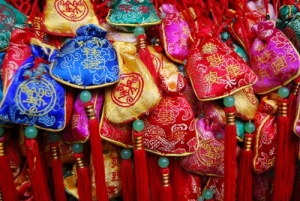After a 27 hour train ride, Aaron and I arrived in Chengdu, the biggest city of the western Chinese provinces. I’ve been waiting for this trip since I decided to come to China for two main reasons; Sichuan is the main home of the awesome giant pandas and the biggest Buddha statue in the world in the small city of Leshan.
Green Ram Temple and Huan Hua Xi Yuan (park)

After arriving, we checked into our hostel, Lazybones, and then began wandering the city. We made our way to the main square in the center of the city where the Great Helmsman salutes passersby. From there we wanted to find the Green Ram Temple in the western part of the city.

We found it near a nice big park that is now fully equipped to act as an emergency center, most likely in response to the Sichuan earthquake in 2008. The temple is a Tang-era Taoist temple with mostly Ming and Qing-era buildings. The temple is very nice with beautiful gardens and some amazing frescos on the walls in the Temple of the Two Immortals that is also part of the complex.
The Green Ram Temple gets its name from two statues of bronze rams outside the main hall. One looks like a ram. The other looks like a mythical creature as it is made up of pieces from all twelve of the animals from the Chinese Zodiac. I could only tell a few of the animals.
After the temples, we wandered through the peaceful green parks littered with open-air tea houses, lush water features and old people on strolls. The only problem is the number of mosquitoes. It is a nice sanctuary in a grand city.



Jinli Market and Face-Changers

From there we walked to the Tibetan neighborhood that is mostly shops with Tibetan religious trinkets, clothes and art. Near this neighborhood is the Wuhou Temple, which at 60 RMB we decided to pass. However, around the temple is a nice park and series of winding allies of food vendors, souvenir stalls and shops.

As we meandered we found a tea house with an opera singer posing for photos out front. Curious, we checked it out. It ended up being a tea house theater where you get to watch a show highlighting Sichuanese culture just by purchasing a cup of tea. We don’t drink tea, so we got a cheap cup of chrysanthemum tea, flowers in hot water, for 15 RMB so we could see the show.
The show was a nice showcase of culture that was more than worthy of 15 RMB. The performance included Chinese opera, folk instruments, a puppet dance, storytelling and the seemingly magical face-changing opera. This last is a must see for someone visiting Chengdu, and since we didn’t want to pay to see a full opera (heard enough of it to know I wouldn’t enjoy two hours of it) this was a fantastic way to see the mysterious art.
It was a great first day in Chengdu with a couple more to come before heading off to Gansu province and the desert.





